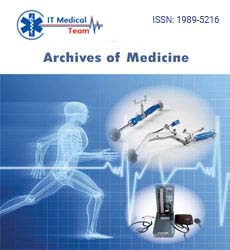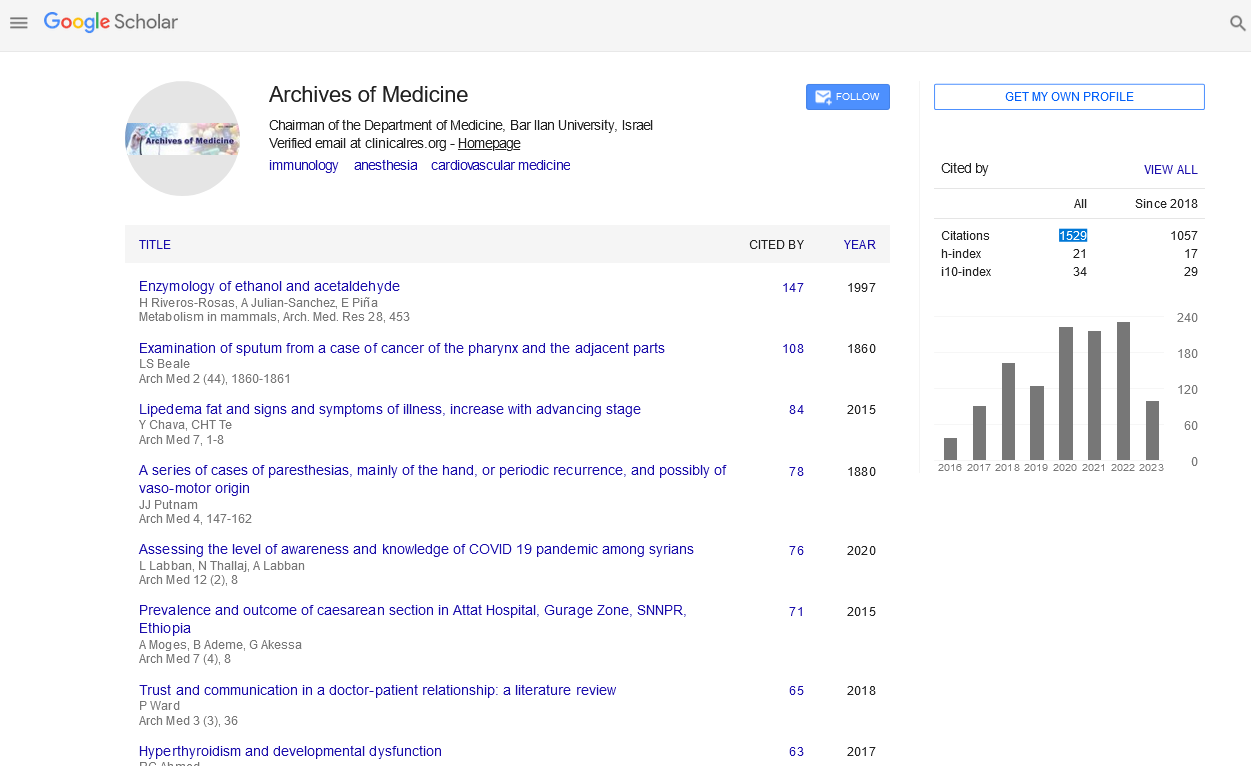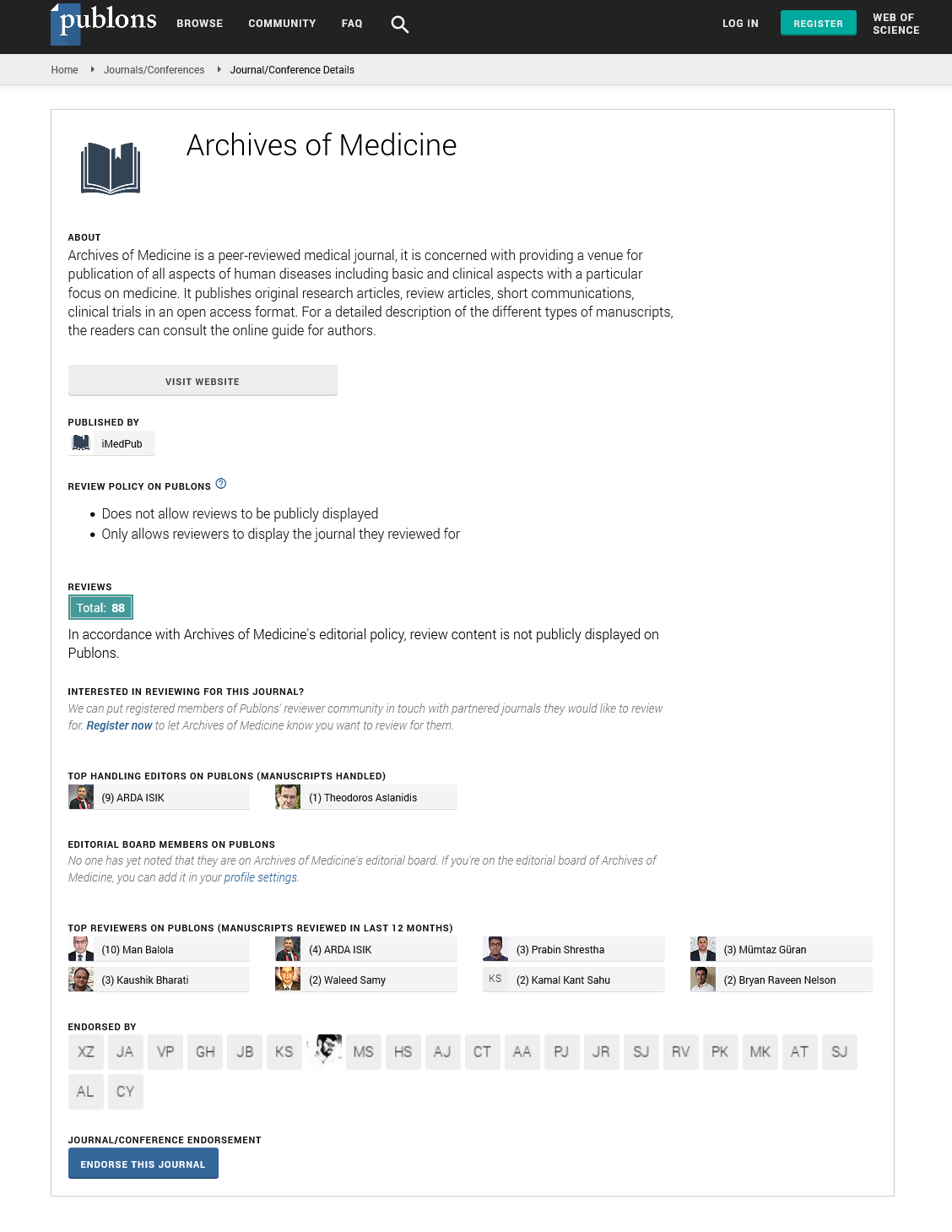Commentary - (2024) Volume 16, Issue 3
Therapeutic triumphs: Advancements in toxicology and treatment
Eleanor Shade*
Department of Cellular & Molecular Medicine, University of California, San Diego School of Medicine, CA, USA
*Correspondence:
Eleanor Shade, Department of Cellular & Molecular Medicine, University of California, San Diego School of Medicine, CA,
USA,
Email:
Received: 01-May-2024, Manuscript No. ipaom-24-14990;
Editor assigned: 03-May-2024, Pre QC No. P-14990;
Reviewed: 15-May-2024, QC No. Q-14990;
Revised: 22-May-2024, Manuscript No. R-14990;
Published:
29-May-2024
Introduction
In the intricate tapestry of modern medicine, toxicology stands as a sentinel against the perils of poisons and toxins that threaten human health. Over the centuries, humanity has grappled with various forms of toxicity, from venomous bites to chemical exposures, each posing unique challenges to medical science. However, the relentless march of progress has led to remarkable advancements in toxicology and treatment modalities, fostering therapeutic triumphs that have revolutionized patient care and saved countless lives. This essay delves into the multifaceted landscape of toxicology, exploring its historical roots, contemporary challenges, and the groundbreaking innovations that have propelled it forward. Advancements in toxicology represent a dynamic frontier in scientific inquiry and medical innovation, continually evolving to address emerging challenges in public health and environmental protection. From its historical roots in ancient civilizations to the present day, toxicology has witnessed a remarkable trajectory of progress driven by interdisciplinary collaboration, technological breakthroughs, and a deepening understanding of the complexities of toxic exposures [1].
In recent decades, the field has seen significant advancements in several key areas:
The advent of advanced analytical techniques, such as mass spectrometry and high-throughput screening, has revolutionized toxicological research by enabling the rapid identification and characterization of toxic substances. These technologies allow toxicologists to explore the mechanisms of toxicity at the molecular level and assess the safety of chemicals more effectively.
Computational modeling and predictive toxicology have emerged as powerful tools for assessing the potential health risks associated with chemical exposures. By leveraging data from diverse sources, including genomic databases and chemical libraries, computational approaches enable researchers to prioritize chemicals for further testing, predict toxicological endpoints, and optimize risk assessment strategies. The integration of omics technologies, such as genomics, transcriptomics, proteomics, and metabolomics, has revolutionized toxicological research by providing comprehensive insights into the biological effects of toxicants. These approaches facilitate the identification of biomarkers of exposure, susceptibility, and adverse outcomes, thereby enhancing our understanding of the mechanisms underlying toxicity and informing personalized risk assessment and intervention strategies.
The development and validation of alternative testing methods, including in vitro assays, organ-on-a-chip technologies, and computational models, offer promising alternatives to traditional animal testing approaches. These methods provide faster, more cost-effective, and ethically superior means of assessing chemical safety and toxicity, thereby reducing reliance on animal experimentation and accelerating the pace of toxicological research. The integration of big data analytics and informatics platforms enables the mining and synthesis of vast amounts of data from diverse sources, including clinical trials, epidemiological studies, environmental monitoring programs, and social media. By harnessing the power of big data, toxicologists can gain deeper insights into the complex interactions between environmental exposures, genetic factors, and human health outcomes, facilitating more precise risk assessment and decision-making.
Overall, the continuous advancement of toxicology promises to enhance our ability to identify, assess, and mitigate the adverse effects of chemical exposures on human health and the environment. By embracing new technologies, methodologies, and interdisciplinary approaches, toxicologists are poised to address emerging challenges and pave the way for a safer and healthier future.
Description
The origins of toxicology can be traced back to ancient civilizations, where rudimentary knowledge of poisonous substances was cultivated out of necessity for survival. Early civilizations such as the Egyptians, Greeks, and Chinese documented various toxic agents and their effects, laying the foundation for the discipline. Ancient texts like the Ebers Papyrus and the works of Hippocrates contain valuable insights into early toxicological knowledge, including antidotes and treatments for poisoning.
The Renaissance era witnessed a resurgence of interest in toxicology, spurred by advancements in chemistry and medicine. Paracelsus, often regarded as the father of toxicology, emphasized the principle of "the dose makes the poison," challenging prevailing notions of toxicity. His revolutionary ideas paved the way for modern toxicological principles and methodologies [2].
The Industrial Revolution brought about unprecedented changes in society, accompanied by new challenges in toxicology. The proliferation of industrial chemicals and environmental pollutants necessitated the development of systematic approaches to assess their toxicity. This era also saw the emergence of occupational toxicology, focusing on the health effects of workplace exposures.
In the modern era, toxicology confronts a myriad of complex challenges driven by rapid technological advancements, globalization, and environmental degradation. The globalization of trade has led to the widespread distribution of chemicals, raising concerns about their safety and regulatory oversight. Additionally, emerging contaminants such as microplastics and pharmaceutical residues present novel challenges to toxicologists and environmental scientists. The advent of new technologies, such as nanotechnology and genetic engineering, has introduced novel substances with unknown toxicological profiles. Assessing the potential risks posed by these innovative materials requires interdisciplinary collaboration and advanced analytical techniques. Furthermore, the interconnectedness of global ecosystems necessitates a holistic approach to toxicology, considering the cumulative effects of multiple stressors on human and environmental health. The rise of drug-resistant pathogens poses a significant threat to public health, underscoring the importance of antimicrobial stewardship and infection control measures. Moreover, the opioid epidemic has highlighted the devastating consequences of substance abuse, prompting efforts to enhance addiction treatment and mitigate overdose deaths [3].
Advancements: Despite the formidable challenges posed by toxicological threats, recent decades have witnessed remarkable advancements in treatment modalities, offering new hope to patients facing poisoning emergencies. The field of toxicology has benefitted immensely from innovations in pharmacotherapy, antidote development, and supportive care interventions. One of the most significant therapeutic triumphs in toxicology is the advent of antidotes for venomous bites and stings. Antivenoms derived from animal sera have been lifesaving interventions for envenomation caused by snakes, spiders, scorpions, and other venomous creatures. Additionally, advancements in supportive care, including respiratory and cardiovascular support, have improved outcomes for critically ill patients.
The development of chelating agents represents another milestone in toxicology, enabling the removal of heavy metals and other toxic substances from the body. Chelation therapy has proven effective in treating lead poisoning, mercury toxicity, and certain forms of acute metal intoxication. Furthermore, advancements in extracorporeal treatments, such as hemodialysis and hemoperfusion, have expanded the therapeutic armamentarium for managing severe poisonings. In the realm of pharmaceutical toxicology, the emergence of targeted antidotes has revolutionized the management of drug overdoses and poisonings. Antidotes like naloxone for opioid overdose and flumazenil for benzodiazepine toxicity have become indispensable tools for emergency physicians and toxicologists. Moreover, advances in supportive care strategies, including intravenous fluids and vasopressor therapy, have improved outcomes for patients with drug-induced organ toxicity [4].
Looking ahead, the field of toxicology stands poised at the nexus of innovation and adaptation, as it grapples with emerging challenges and opportunities. The integration of advanced technologies, such as artificial intelligence and predictive modeling, holds promise for enhancing toxicity testing and risk assessment methodologies. By leveraging big data analytics and high-throughput screening platforms, toxicologists can expedite the identification of hazardous substances and prioritize regulatory interventions. Furthermore, the growing emphasis on personalized medicine offers new avenues for tailoring toxicological assessments and treatment strategies to individual patients. Pharmacogenomic testing, which examines genetic variations in drug metabolism and response, can inform dosing regimens and reduce the risk of adverse drug reactions. Similarly, advances in biomarker research hold potential for early detection of toxic exposures and monitoring of treatment responses.
Environmental toxicology stands at the forefront of efforts to mitigate the impacts of pollution and climate change on human health and ecosystems. Through interdisciplinary research collaborations and community engagement initiatives, toxicologists can address pressing environmental health concerns and advocate for evidence-based policy interventions. By fostering greater awareness of environmental risks and promoting sustainable practices, toxicology can contribute to building resilient and healthy communities for future generations [5].
Conclusion
In conclusion, the journey of toxicology from ancient remedies to modern therapeutics epitomizes the triumph of human ingenuity over the forces of toxicity and harm. Through centuries of discovery and innovation, toxicologists have unraveled the mysteries of poisons and toxins, paving the way for life-saving interventions and preventive measures. While the challenges of toxicology continue to evolve in the face of emerging threats and complexities, its enduring mission remains unchanged: to safeguard human health and protect the natural world from the perils of toxicity. As we navigate the uncharted terrain of the 21st century, let us draw inspiration from the triumphs of the past and chart a course towards a safer, healthier future for all.
Acknowledgement
None.
Conflict of Interest
None.
References
- Navarro KM, Clark KA, Hardt DJ, et al. Wildland firefighter exposure to smoke and COVID-19: A new risk on the fire line. Sci Total Environ. 2021;760:144296.
Google Scholar, Crossref, Indexed at
- Fulgenzi A, Ferrero ME. EDTA chelation therapy for the treatment of neurotoxicity. Int J Mol Sci. 2019; 20(5):1019.
Google Scholar, Crossref, Indexed at
- Ho TT, Gift M, Alexander E. Prioritizing pharmacogenomics implementation initiatives: A survey of healthcare professionals. Per Med. 2022(1):15-23.
Google Scholar, Crossref, Indexed at
- Bjørklund G, Aaseth J, Crisponi G, et al. Insights on alpha lipoic and dihydrolipoic acids as promising scavengers of oxidative stress and possible chelators in mercury toxicology. J Inorg Biochem. 2019;195:111-119.
Google Scholar, Crossref, Indexed at
- Qian Z, Liu C, Huang J, et al. Identification of the designer benzodiazepine 8-chloro-6-(2-fluorophenyl)-1-methyl-4 H-[1, 2, 4] triazolo [4, 3-a][1, 4] benzodiazepine (flualprazolam) in an anesthesia robbery case. Forensic Toxicol. 2020; 38:269-276.
Google Scholar, Crossref, Indexed at






